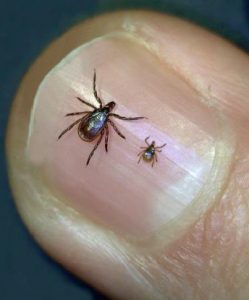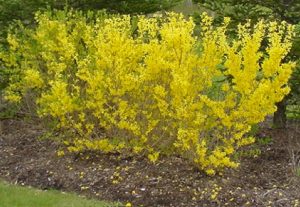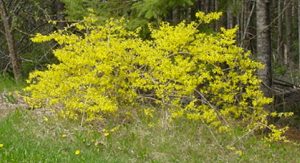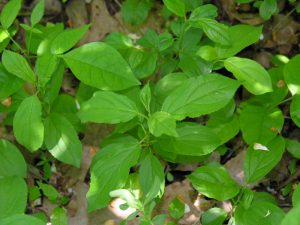Maine Home Garden News — May 2014
- May Is the Month to . . .
- Pruning Your Forsythia
- Three Ways to Manage Invasive Plants in Your Landscape
- The Seed — What a Remarkable Package!
- Garden Clubs Project at Long Creek in South Portland
- Food & Nutrition: Fiddleheads and Rhubarb: Maine Foods for May
By Richard Brzozowski, Extension Educator, University of Maine Cooperative Extension Cumberland County, richard.brzozowski@maine.edu

- May in Maine typically means ticks. If you work outdoors, you are at risk for tick bites. For information about ticks, see Bulletin #5047, Ticks or visit the UMaine Extension Tick ID Lab website. To obtain a form to submit a tick for identification ($10 per tick), visit your local UMaine Extension county office or see Submitting Your Tick for Identification. To learn more about ticks and Lyme disease, see Tick-Borne Diseases.
- “Harden off” purchased or self-grown seedlings by gradually acclimating them to winds, fluctuating temperatures, and other outdoor conditions.
- Plant cold crop seedlings (cauliflower, broccoli, cabbage, etc.) and onions. May is also a typical time to sow carrots, brussels sprouts, lettuce, leeks, beets, celery, early sweet corn, dill, peas, radish, spinach, turnip, parsley or parsnips. Plant potatoes in May, too.
- Plant vine crops like cucumbers, summer squash, and winter squash, as well as warm season crops like tomatoes, peppers, and eggplants, in late May. After transplanting your seedlings, watch for frost threats and be ready to cover tender plants if needed.
- Make sure your lawn mower is ready to use: sharpen mower blade(s), check for adequate oil and change oil if needed, add a new spark plug, and ensure that all safety features are functioning properly and the wheels are in good working order. Lawn mowers take a beating. Make sure yours is safe and running smoothly.
- Inventory your personal protective equipment (PPE) and replace items as needed. Gardeners should use basic PPE such as safety glasses or goggles, work gloves, nitrile gloves for pesticide handling, dusk masks, and ear protection. An injury could put you on the “side-line” and keep you from gardening.
- Assess your perennial beds for proper weed management. Remove any weeds. Freshen mulch as needed.
- Consider using a phosphorous-rich “starter solution” as a fertilizer when setting out seedlings. Phosphorous (even though it is present) may not be available to plants in Maine’s cold spring soil. By adding a fertilizer with a high phosphorous value (the middle number in fertilizer analysis N-P-K), you will promote the rooting of new seedlings. Fertilizers such as 10-20-10 or 15-30-15 provide readily available phosphorous.
- Remove caterpillar nests from small trees and shrubs with a gloved hand or clip off the stem supporting the nest with shears. Dispose of the sticky nest in the trash, bury it in your compost pile, or submerge the nest in soapy water. Removal of the nests will considerably reduce the caterpillars that defoliate your trees. Do not use flame (torches) to destroy the nest. This is very risky and will likely damage the tree.
Pruning Your Forsythia
By Marjorie Peronto, Extension Educator, University of Maine Cooperative Extension Hancock County, marjorie.peronto@maine.edu
Forsythias are easy to grow, but do require some maintenance. Pruning is the most important chore. Forsythias have a naturally graceful arching growth habit, but they can be their own worst enemy. Left unpruned, they will become too large, wild, and unruly. A neglected forsythia can overwhelm neighboring plants and surroundings, and become unhealthy. By doing some maintenance pruning each year, you help keep the plant in bounds, assure good light penetration and air circulation, and reduce the likelihood of disease.
When to Prune Your Forsythia
Shrubs that bloom in the early spring, such as forsythia and lilac, are usually pruned just after they finish blooming.
Forsythias start developing next year’s flower buds in early to mid-summer. They carry these buds through the fall and winter, to burst open the following spring. If we prune forsythia in the late winter while it is still dormant, we remove branches that have pre-formed flower buds, reducing the upcoming spring flower display.
When the shrub is overgrown, has gangly branches or has been neglected for years, its flower display is not what it could be. In this case, it might be worth it to prune it when dormant and sacrifice a year of blooms. Pruning while the plant is dormant is easier, because you can clearly see how the branches grow in relation to one another.
How to Prune Forsythia
1. When pruning a mature forsythia, each year start by selectively removing one-fourth of the oldest stems at ground level. These stems will have the largest basal diameter. As stems get thicker with age, they rub against one another in the interior of the shrub, causing wounds that weaken them. The oldest, thickest stems are also the tallest, so by removing these, you bring the height of the shrub down without changing the shrub’s natural form.
Use a pair of loppers or a small, fine-toothed hand saw for removing large stems. If you cannot get to the base of a large stem because the area is too congested, prune it back as close to the ground as you can. In some cases, however, you might purposefully choose to leave a foot or more of old stem behind. This will result in new shoots emerging from unseen buds embedded within that stem.
2. Next, thin out congested branches in the canopy. “Thinning” is done by cutting a branch back to its point of origin on a main stem. This method is the least conspicuous of all types of pruning, and maintains the plant’s natural growth habit.
While thinning, identify and remove
- any dead, damaged or diseased branches
- branches that are growing inward, towards the center of the plant
- branches that are crossing or rubbing other branches
- some of the tallest vigorously upright shoots

Thinning the canopy should be done with hand pruners or loppers, depending on branch diameter. Make each cut at the point where a branch originates from another stem and do not leave a stub.
Resist the urge to shear off the top of the plant with hedge clippers. Shearing may be faster, but branches will respond by putting out excessive, dense brushy growth at the stem tips.
When you are finished, you will have a shrub with stems of various ages that are growing upward and outward, revealing the natural, fountain-like form of the plant.

You should be able to toss a football easily through the shrub.
The open habit will allow light and air into the center of the shrub, stimulating sturdy new shoots to emerge from the crown and remaining stems, which will give you flowers in future years.
Three Ways to Manage Invasive Plants in Your Landscape
By Dr. Lois Berg Stack, Extension Specialist, Ornamental Horticulture, University of Maine, lois.stack@maine.edu
Weeds have always challenged home gardeners. Many Maine gardeners struggle to manage quackgrass in garden beds, galinsoga in vegetable gardens, bishop’s goutweed in shrub borders, and ground ivy in shady lawns. We identify these weeds, eradicate them, and if we follow up with good management practices we can get ahead of them.
In the past few decades, more and more Maine gardeners have struggled with more serious weeds – plants that not only compete against our garden and landscape plants, but also threaten native plants in wild areas.
In wild areas, these plants cause many disruptions, specific to biological potential of the plants themselves and to the characteristics of the wild sites.
Here are just two examples.
- Asiatic bittersweet (Celastrus orbiculatus) seeds are deposited in wooded areas by birds. The resulting seedlings can remain small in the understory, but when a storm or other event opens up a spot in the woods and increases the light level, Asiatic bittersweet takes advantage by quickly growing upward to envelop the trees above it. This reduces tree vigor by preventing them from receiving full light for photosynthesis, but it also adds weight to the trees and over time twines around the trees’ branches and girdles them, sometimes killing them.
- Japanese barberry (Berberis thunbergii) seeds are eaten and transported by birds and other small animals. Barberry seeds germinate readily in either sunny or shaded sites, so the plants grow at woodland edges and also deeper in the forest. Deer that graze in these sites eat nonthorny native plants in preference to the sharp-thorny barberry stems, thereby reducing the competition that might keep the barberry in check. There are places in Maine forests where solid stands of Japanese barberry now form large impenetrable thickets. In addition to outcompeting native plants, Japanese barberry’s arching thorny stems leaf out early in the season and provide cover for small mammals like white-footed mouse, which carries blacklegged ticks, the vectors of Lyme disease and other serious diseases. That makes this invasive plant a threat not only to our wild areas, but also to human health.
There are some actions you can take to get ahead of invasive plants in your landscape. As a bonus, your actions will reduce the likelihood that seeds from those plants will generate new plants the can invade wild areas.
Action 1: Don’t buy invasive plants.
Learn which plants are invasive in your area, and avoid them in the marketplace. Several plants that are known to be invasive in Maine wild areas can be purchased either at local businesses or on the internet. Find alternatives! For example, instead of planting burningbush for its red fall foliage, why not plant redvein enkianthus (Enkianthus campanulatus)? It has elegant pink and white flowers in spring, and beautiful fall foliage. Try red chokeberry (Aronia arbutifolia), a 6’-10’ shrub with red fall color. Instead of the red fall foliage of burningbush, why not plant Maine’s native winterberry (Ilex verticillata) with its bright red fall fruits? Another very choice shrub valued for its fall foliage is fothergilla (Fothergilla gardenii and Fothergilla major). Its unusual white flowers attract everyone’s attention in spring, and its tutti-frutti fall color is unsurpassed.
Action 2: Rogue out mature invasive plants from your landscape.
You may never have seen seedlings pop up under an invasive plant that has long been in your landscape. For example, it’s common for purple loosestrife (Lythrum salicaria) to be perfectly well behaved in a perennial border. But its seeds are carried by water to wetlands, where it has become a very serious threat to habitat that is critical to water fowl. You might remove the fruits from an invasive plant in your yard, before its seeds are mature, and falsely think you’ve solved the problem. But if that plant has been visited by pollinators who have carried its pollen to other plants that do produce seeds, then your plant is part of the invasion process.
Of course, after you’re removed a mature invasive plant, you’ll want to plant something in its place. Digging out big plants is a process that brings many seeds to the surface, where they are much more likely to germinate and grow. Select a replacement plant, install it, water well and mulch.
Action 3: Remove plants that are invading your landscape when you first see them, before they have a chance to reproduce and make the problem worse.
In my yard, I have learned that two invasive species account for nearly all of the new invasive plants I see: sweet autumn olive (Elaeagnus angustifolia) and common buckthorn (Rhamnus cathartica). Over time, I have learned where they show up most frequently: under landscape plants that produce fruits that attract birds, and under plants whose low growth hides young seedlings until they are well established. I concentrate my scouting efforts on those places.

This photo (right) shows common buckthorn seedlings under a crabapple in my yard. Birds ate buckthorn fruits at a woodland edge, carried the seeds into the yard in their digestive tracts, perched on the crabapple to eat some fruits, and deposited the invasive plant seeds that grew into these plants. At this young stage, these seedlings are easy to rogue out. Their root systems are small, and pulling them does not greatly disturb the soil or the roots of the crabapple. If I left the plants to grow for just a season or two, they would be much more difficult to remove.
Not sure which plants are invasive in Maine?
UMaine Extension offers fact sheets about many of Maine’s invasive plants. Visit our Publications Catalog and look for Maine Invasive Plants to learn which plants are invading Maine, how to identify them, what makes them invasive, and how to manage them.
The Seed — What a Remarkable Package!
By Richard Brzozowski, Extension Educator, University of Maine Cooperative Extension Cumberland County, richard.brzozowski@maine.edu
Everyone is familiar with the story of John Chapman or “Johnny Appleseed” and how he took seeds from a cider press in Pennsylvania, washed them of the pomace and transported them by canoe to later sow in the wilderness across the country. There are numerous stories and accounts of people in history who brought, spread, and used seeds to benefit others as well as to benefit animals. Seeds have played an important role in history.
Have you ever stopped to wonder about these tiny packages of energy? Within a seed is an embryonic plant, the beginning of a new generation.
Seeds are borne from two distinct plant classes: Gymnosperms (meaning naked seeds) and Angiosperms (vessels for seeds). Conifers or cone bearing plants such as pine and hemlock are Gymnosperms, as are cycads or palm like plants. The seeds from Angiosperms are most common to home gardeners because that is typically what we buy, handle, and sow in our gardens to produce flowers, vegetables or herbs. They are flowering plants.
Seeds come in all shapes and sizes depending on the species. Some seeds stay viable for a mere few hours (such as the willow) while others may remain viable for up to 300 years (Oriental Lotus). What a remarkable package!
What triggers a seed to germinate? Adequate moisture, oxygen, and a suitable temperature must exist for germination. Some seeds require light in addition to these conditions to germinate. The process starts by water moving through the seed coat or coats into the embryo. The moisture causes swelling of the seed. The seed coat ruptures and growth begins. Where does the seed get its energy for growth? Foodstuffs stored in the endosperm or in the cotyledon (first leaves) provide the energy for the first growth before sunlight and photosynthesis takes over.
When you start your seeds this spring or sow seeds in your gardens, make the connection to the people and plants that came before us. By gardening, you are playing a part in the continuance of life. Wow! Have you ever reflected on that before?
To learn more about seeds, saving seeds, and sowing seeds, inquire at your local library, search the Internet, or see our Bulletin #2750, An Introduction to Seed Saving for the Home Gardener. A great historical reference on seeds is the 1961 USDA Yearbook of Agriculture: Seeds (PDF).
Garden Clubs Project at Long Creek in South Portland
By Nini McManamy, Cumberland County Master Gardener Class of 2003
Sometimes life takes you to places you didn’t know you wanted to go. When I was a kid, just the sight of the brick hill at the former Boys Training School, later Maine Youth Center and now Long Creek Development Center in South Portland, was enough to scare me into behaving myself. I was nervous just driving by. But three years ago, while working at South Maine Community College (SMCC), my dean asked me to teach a college study skills course there, and I said yes. I fell in love with the place. Today, I volunteer two days a week with the Garden Clubs in winter and summer.
As I write this, we are starting seeds indoors for transplant into our 60′ x 100′ garden bed as soon as the water drains out of the field. We are also beginning to terminate some of the experiments we have been growing under lights indoors, including the hydroponics table the students built. There are two Garden Clubs, one for boys and one for girls, since they do not have classes together. The clubs grow food for the kitchen at Long Creek. The kids fight woodchucks, geese, drought, and bugs like gardeners everywhere. Last year, we had huge success with tomatoes, basil, various greens, and onions. We are hoping for a harvest from our new blueberry bushes this year.
The students get academic credit for the Garden Clubs, but because the population is fluid, maintaining the academic part of the curriculum is a challenge. The program is run by a partnership between a math teacher and a science teacher — who unfortunately left for an unexpectedly lengthy maternity leave in December, leaving me with a bit more responsibility than I anticipated. The math teacher, Susan Finch, provides great leadership to all of us, is an avid gardener, and is much respected by the students. We hope the newly hired science replacement arrives soon, but getting all the background checks completed takes a while. For me, even though I had taught there previously, it took two months to get cleared to volunteer.
Last week we planned the garden. First we identified the wetter areas, then we identified zones for different pH preferences, based on soil treatments we applied last fall as well as pH testing with kits. Next, we took our brainstormed list of desired crops and used the identified soil conditions to place them on the map. Using software we received from Kitchen Gardens International (thanks to a grant written by one of the teachers and one of the students), we created and printed some lovely colored plans for the garden.
We enjoyed a career talk last week by the horticulturist from the city of South Portland, and two students who have earned off-campus privileges (the best motivator there is — off-campus status is necessary if you are on a sports team or have a job in the community) will be taking a field trip next week to the greenhouse at SMCC, a first-ever college visit for those boys.
Meanwhile, we are anxiously awaiting the installation of our new greenhouse, built by the students over the winter in shop class. The platform was installed by students with construction experience last fall next to our tool shed. Like all gardeners, we can’t wait to get outdoors.
Food and Nutrition
Fiddleheads and Rhubarb: Maine Foods for May
By Kathy Savoie, MS, RD, Extension Educator, University of Maine Cooperative Extension Cumberland County, ksavoie@maine.edu
Two of spring’s early edible treats in Maine include rhubarb and fiddleheads. Both of these foods are a pleasure to enjoy in your favorite recipes and these are both very easy to preserve. Once preserved, they can be used and enjoyed again in the off-season. If you are looking to amp up your intake of local foods, preserving is a skill to learn to help extend your access to local foods year round. Check out our upcoming hands-on food preservation workshops.
Using, Storing, and Preserving Rhubarb
Rhubarb, a spring tonic for vitamin C and calcium, is an easy and versatile fruit to use, although it provides only a moderate source of fiber. One of the drawbacks is that because it is so tart, most recipes call for more sugar than most other desserts. As with other fruits, 1/2 cup cooked rhubarb is considered a serving. A serving without sugar is only 29 calories, but with sugar it is 139 calories. By combining the stalks with sweeter fruits, like strawberries, the sugar content can be lowered quite a bit.
To store rhubarb, cut off the leaves, wash the stalks, and store them in a plastic bag in the crisper of the refrigerator. Use within one week. (Caution: Rhubarb leaves contain a toxic substance that makes them poisonous. Be sure the leaves are removed before using the stalks. Discard them without cooking or eating.) For recipes on how to use fresh rhubarb, see Bulletin #4266, Vegetables and Fruits for Health: Rhubarb.
Freezing rhubarb is a simple and quick way to preserve it. Watch how in our video on freezing rhubarb.
Because rhubarb is a high-acid product, it can safely be processed in a boiling water bath. For directions on how to can stewed rhubarb, check out Selecting, Preparing and Canning Fruit: Rhubarb — Stewed from the National Center for Home Food Preservation.
Using and Preserving Fiddleheads
Fiddleheads, an early spring delicacy throughout their range, are the young coiled fronds of the ostrich fern (Matteuccia struthiopteris). Many people mark the arrival of spring with a fiddlehead-picking outing.
Some important food safety advice for fiddlehead consumers: The Center for Disease Control and Prevention (CDC) has investigated a number of outbreaks of food-borne illness associated with fiddleheads. The implicated ferns were eaten either raw or lightly cooked (sautéed, parboiled or microwaved). The findings of this investigation recommend that you should cook fiddleheads thoroughly before eating (boil fiddleheads for at least 15 minutes).
For information and recipes on how to use, store, and preserve (freezing and pickling) fiddleheads, see Bulletin #4198, Facts on Fiddleheads.
University of Maine Cooperative Extension’s Maine Home Garden News is designed to equip home gardeners with practical, timely information.
Let us know if you would like to be notified when new issues are posted. To receive e-mail notifications fill out our online form.
Contact Lois Elwell at lois.elwell@maine.edu or 1.800.287.1471 (in Maine).
Visit our Archives to see past issues.
Maine Home Garden News was created in response to a continued increase in requests for information on gardening and includes timely and seasonal tips, as well as research-based articles on all aspects of gardening. Articles are written by UMaine Extension specialists, educators, and horticulture professionals, as well as Master Gardener Volunteers from around Maine, with Professor Richard Brzozowski serving as editor.
Information in this publication is provided purely for educational purposes. No responsibility is assumed for any problems associated with the use of products or services mentioned. No endorsement of products or companies is intended, nor is criticism of unnamed products or companies implied.
© 2014
Call 800.287.0274 or TDD 800.287.8957 (in Maine), or 207.581.3188, for information on publications and program offerings from University of Maine Cooperative Extension, or visit extension.umaine.edu.
